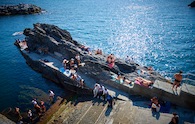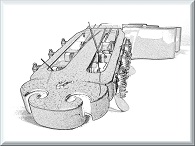Welcome to one of the most active flamenco sites on the Internet. Guests can read most posts but if you want to participate click here to register.
This site is dedicated to the memory of Paco de Lucía, Ron Mitchell, Guy Williams, Linda Elvira, Philip John Lee, Craig Eros, Ben Woods, David Serva and Tom Blackshear who went ahead of us.
We receive 12,200 visitors a month from 200 countries and 1.7 million page impressions a year. To advertise on this site please contact us.
|

|
|
Adjusting action and intonation?
|
You are logged in as Guest
|
|
Users viewing this topic: none
|
|
Login  | |
|

   
estebanana
Posts: 9351
Joined: Oct. 16 2009

|
 RE: Adjusting action and intonation? (in reply to Escribano) RE: Adjusting action and intonation? (in reply to Escribano)
|
|
|
Steel strings guitars did not have truss rods until quite late in production, the common thing to do is remove the neck and reset it. Even a guitar with a truss rod might at some point need a neck reset. But this is part of that guitar repair culture. The nylon string guitars don't have as much tension, when you set them up to check neck relief, a nylon string neck might take over night to pull forward under tension into full position, while a steel string neck will usually pull up in 30 minutes or less. Two really different structures are working.
Ruphus mentioned carbon fiber rods; many makers are imbedding them under the fingerboard on nylon string guitars. It keeps the neck stiff so the neck itself is not going to bend as much in compression. So then the the issue is neck angle which has to be correct for the string height the player wants. If the carbon fiber is in the neck that pretty much removes the factor of the neck bending forward making excess neck relief, so the relief is planed into the fingerboard.
Here's the salient point:
Even on a steel string guitar with a truss rod you still may have to reset the neck to get the right angle, many necks with rods have dove tail joints at the neck block so they can be removed and reset. The rod is to hold the neck relief stable against the compressive force of the tension. It is not to set the neck angle, although there is a certain amount of "slop" in the system which allows for steel string guitars in need of a neck reset to be triaged into playing even with the wrong neck angle. You see them come into a shop with high saddles and the truss rods maxed out and the guitar teeters on the edge of being playable.
When that situation happens to a nylon string guitar there a few courses of action depending on the condition of the structure;
Remove frets and replane neck to regain better neck angle.
Replace fretboard and replane.
Take off the back and reset the neck.
Correct neck relief by removing fingerboard and installing carbon fiber rods. Especially effective on guitars with "whippy" flexible necks which have relief issues.
There are other things to do depending on condition of the structure but those are some ideas.
__________
So truss rods are good, but nylon string guitars typically don't have the same issue that modern steel strings have. They don't have the amount of tension compression generated by heavy gauge steel strings which causes the neck to bend forward and compromise the neck relief. The carbon fiber has proven to work that issue with nylon tension. And the neck angle can be reset.
You can also saw the neck off and reset it with a spline joint or bolt on connection. Those are perfectly good and time test options today.
Even though it might be beneficial in many cases, if you put truss rods in flamenco guitars today as an individual maker you could have trouble selling the guitar. Cordoba and a few other lines mentioned can be had with truss rods. One problem is not the truss rod itself, but selling a guitar with a truss rod in the flamenco market can be difficult. Guitar buyers often have irrational ideas about form and tradition. If truss rod was not used in earlier guitars they will question it.
I hope that helps with some additional information regarding the OP's question.
_____________________________
https://www.stephenfaulkguitars.com
|
|
|
|
REPORT THIS POST AS INAPPROPRIATE |
Date May 23 2014 1:24:23
 |
|

   
estebanana
Posts: 9351
Joined: Oct. 16 2009

|
 RE: Adjusting action and intonation? (in reply to Escribano) RE: Adjusting action and intonation? (in reply to Escribano)
|
|
|
Yes there is. As soon as you take the board off the neck clamp it into a holding caul that you make ahead of time.
You need an absolutely flat stiff piece of something wide enough for the fingerboard, like a piece of thick plywood with a 1x2 glued to it lengthwise. This will serve as a bed to keep the board from warping.
Then make another piece of plywood the same size, it can be a bit thinner if you like, and drill 1/2" holes in it about every 1" - no big deal on accuracy, just give it a bunch of holes.
When the finger board comes off the guitar, carefully remove any cedar neck splinters and save them, scrape any excess glue and lay it on the stiffened caul then clamp the piece with the holes on top of it to flatten it on the caul.
The holes are to let moisture out so it does not trapped. You can keep the board in that fixture until you are ready to put it back on and it should stay flat.
If you have to keep a finger board with frets, you can make a slotted caul with a router or saw and chisel to make slots for the fret. Then the flat surface of the board indexes only on the wood and not the frets.
It sounds like a lot of work, and it is. Repair work is usually more that 50% of your time making fixtures to glue and hold things while they glue, or dry, or do some process that involves holding something in place. When you do that same repair over an over on different guitars and have sets of fixtures for the situation you actually start to make money.
_____________________________
https://www.stephenfaulkguitars.com
|
|
|
|
REPORT THIS POST AS INAPPROPRIATE |
Date May 23 2014 21:38:01
 |
|
 New Messages New Messages |
 No New Messages No New Messages |
 Hot Topic w/ New Messages Hot Topic w/ New Messages |
 Hot Topic w/o New Messages Hot Topic w/o New Messages |
 Locked w/ New Messages Locked w/ New Messages |
 Locked w/o New Messages Locked w/o New Messages |
|
 Post New Thread
Post New Thread
 Reply to Message
Reply to Message
 Post New Poll
Post New Poll
 Submit Vote
Submit Vote
 Delete My Own Post
Delete My Own Post
 Delete My Own Thread
Delete My Own Thread
 Rate Posts
Rate Posts
|
|
|
Forum Software powered by ASP Playground Advanced Edition 2.0.5
Copyright © 2000 - 2003 ASPPlayground.NET |
0.09375 secs.
|


 Printable Version
Printable Version











 .
.  New Messages
New Messages No New Messages
No New Messages Hot Topic w/ New Messages
Hot Topic w/ New Messages Hot Topic w/o New Messages
Hot Topic w/o New Messages Locked w/ New Messages
Locked w/ New Messages Locked w/o New Messages
Locked w/o New Messages Post New Thread
Post New Thread